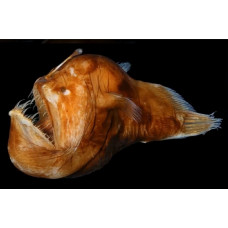Latin name
Melanocetus johnsonii
Other names
Anglerfish, viperfish, fangtoothfish
Identification
Dorsum with compressed posterior and anterior ridges; anterior margin of scutellum almost straight; fine dermal spines present on most of the body. Scales conical, hollow and translucent, with round base and free margin directed towards caudal region. Left otolith oblong in shape with regular margins, no rostrum, antirostrum or fold on inner surface.
Females have short, spherical bodies, large heads with an enlarged, almost vertical mouth and long, pointed teeth. There are numerous small dermal spines under the dorsal fin. Compared to other species in the genus, M. johnsonii has a longer illicium and fewer jaw teeth, but these teeth are relatively longer than in other species. Females have a short dorsal fin spine (illicium) with a bulbous baiting apparatus (esca) on the snout. The esca has compressed posterior and anterior crests. Unlike other species in the genus, the anterior margin of the esca is almost straight in females of this species. Females of M. johnsonii have small subcutaneous eyes, which may indicate that they are not dependent on vision for feeding and breeding.
Males usually have relatively more denticles and dorsal and pectoral fin rays.
Features of fish fins
Dorsal spines (total): 1; Dorsal soft rays (total): 13-17; Anal spines: 0; Anal soft rays: 3-5.
Fish colouring
These fish have a dark brown or black colored body.
Distribution
The species inhabits temperate and tropical areas of all the world's oceans. In the South China Sea and the East China Sea.
Habitat
Deep-sea mesopelagic and bathypelagic species. They inhabit depths from 100 to 4,500 m. Larvae are found mainly above 100 m.
Size
They exhibit extreme sexual dimorphism. A peculiarity of the species is the fact that the male does not exceed 3 cm in length, while the female can reach up to 18 cm.
Behavior
The fish uses very bright photophores on the end of an illicium on its head, similar to a fishing rod, to lure prey. The lure (esca) is made to glow by special bacteria that live in symbiosis with the fish.
Food and feeding habits
Fish are attracted to small crustaceans, myctophids and gonostomatidae by their photophores. Their well-stretched stomachs allow them to swallow prey larger than their size.
Reproduction
Finding a mate is difficult for M. johnsonii because they live solitary and far apart in the deep sea. Males have highly developed sensory organs that allow them to pick up the female's scent. Males of M. johnsonii do not parasitize females, but live separately and only temporarily attach themselves to a larger M. johnsonii female using a unique set of teeth before releasing their sperm. Once this process is complete, the males disperse to find other females. This species is oviparous, with planktonic larvae. The eggs are probably contained in floating gelatinous rafts. Pelagic larvae live in the upper hundred meters of water where they develop into adults.
Fishing
Humpback anglerfish are caught with plankton nets.
Relationship with a person
A species harmless to humans.
| Classification | |
| Phylum | Chordata |
| Class | Actinopterygii |
| Squad | Lophiiformes |
| Family | Melanocetidae |
| Genus | Melanocetus |
| Species | M. johnsonii |
| Features | |
| Conservation status | Least Concern |
| Habitat | Pelagic |
| Life span, years | No information |
| Maximum body weight, kg | No information |
| Maximum length, cm | 18 |
| Sailing speed, m/s | No information |
| Threat to people | Not edible |
| Way of eating | Predator |
Humpback anglerfish
Tags: humpback anglerfish


